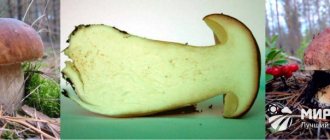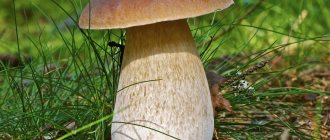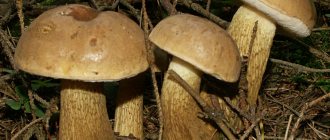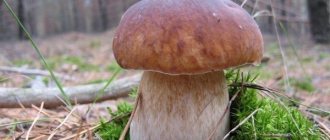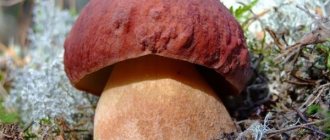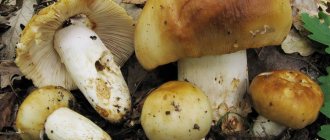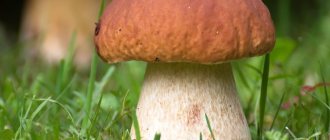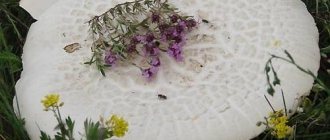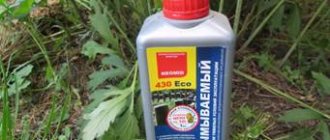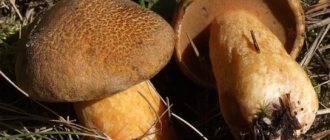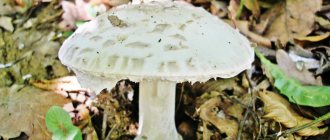Hygrophorus late is an edible mushroom, classified in the 4th taste category. Inexperienced mushroom pickers are most likely completely unfamiliar with this mushroom. This is understandable - inconspicuous, outwardly strongly reminiscent of an unremarkable toadstool, of which there are many.
Experienced mushroom hunting lovers chuckle and, with the words “we’ll get more,” willingly put the harvest in their baskets. And not in vain, because this mushroom is delicious, you don’t need to fuss with it for a long time, preparing it for cooking. And hygrophorus is one of the latest mushrooms, which additionally protects against taking a poisonous mushroom instead.
Types of hygrophores
There are more than 40 subspecies in the Hygroforaceae family:
- early;
- late (brown);
- reddish;
- olive white;
- golden;
- spotted;
- snow white;
- larch;
- black;
- pinkish;
- hygrophor Person, etc.
Similar species, classified as members of the Hygrophoraceae family, were later allocated to the genus Hygrocybe.
Black Hygrofor
Early
Hygrofor early belongs to the edible varieties of mushrooms. The second name of the subspecies is snow mushroom. The diameter of the rounded cap reaches 5-11 cm, the surface is glossy and dense. The color of the mushroom varies from gray-white to dark brown and black. The convex cap becomes flat over time. Villi may appear on the top. The height of the leg reaches 4-10 cm. The shade of the support is white or gray. The pulp of the fruit has a grayish tone. Cut hygrophores have a neutral aroma. The variety has no doubles.
Early hygrophorus bears fruit from early spring until May. The subspecies has become widespread in North America and Asian countries. The species grows in coniferous forests, among larch trees, and bears fruit abundantly in soil saturated with nutrients.
According to the description of experts, the variety does not have medicinal properties, it is used for preparing soups, stir-fries, and it is possible to pickle and marinate fruits.
Late brown
Late hygrophorus (Hygrophorus hypothejus) is olive-brown or yellow-brown in color. The mushroom is edible and full of useful substances. The diameter of the convex cap with concave edges is small (3-7 cm). The leg is golden or light green in color and reaches a height of 4-12 cm.
The surface of the leg is smooth, without fibers. In old mushrooms it may be hollow inside. The plates are dense, pale orange or golden in color. The pulp of the fruit is white or pale yellow in color and has no aroma. Hygrophor bears fruit from early September to late autumn and can withstand frost. The variety grows in pine or mixed forests.
The mushroom has no medicinal properties and is optimal for soups and stir-fries. The variety has no duplicates; its additional name is brown hygrophor.
Hygrophorus late
Blushing
Hygrophorus reddish grows in the northern regions of the Russian Federation, bears fruit from July to early October. The cap is round, up to 4-11 cm in diameter, and has a light pink or rich red tint. The configuration of the cap is convex and conical, the edges are concave and slightly covered with pile.
The height of the leg is 4-10 cm, the support is white, dense, in the shape of a cylinder. The plates are dense, sparse, white-pink. The variety is considered edible, but is not used for frying and soups, because has a bitter taste.
The fruits are collected for pickling and pickling. The variety has no medicinal characteristics.
Olive white
Hygrofor olive-white is a nutritious edible variety. The diameter of the smooth cap with curved edges reaches 4-11 cm. The color of the mushroom is gray-brown. The caps of young mushrooms have the shape of a bell or a circle; over time, the surface straightens. Hygrofor can become covered with fine lint and small growths. The legs grow up to 4-12 cm in height. The cylindrical support is dense, the surface is covered with scales. The hygrophor is supplemented with rare white-green plates. The pulp of the mushroom is tender, without a pungent odor.
The variety has become widespread in Europe and the USA. Olive-white hygrophor bears fruit from August to the first half of October, grows in pine and coniferous forests, occupies lowlands and places with high humidity. This variety of mushrooms has a sweetish taste and is used for soups, main courses, and pickles. The additional name of the variety is sweet tooth mushroom.
Golden hygrophorus
Golden
Golden hygrophorus has an unusual color; there are splashes of yellow on a white background. The diameter of the cap is 4-8 cm. The convex, cone-shaped cap straightens over time. The curved leg reaches 4-7 cm in height, it is elastic, with a porous structure. The plates are dense, milky in color. The pulp is snow-white and has a delicate aroma.
The variety grows in America and European countries, bears fruit from August to the 2nd half of October. Hygrofor grows next to linden and oak trees.
The variety is classified as conditionally edible, is not used for frying, and is recommended as an additive to soups. The taste parameters are average; the subspecies has no medicinal properties.
Spotted
Hygrophorus spotted (vesicular) is edible and has high nutritional characteristics. The variety grows in the territories of European countries. The fruiting period is from September to November. The variety grows in coniferous and mixed forests, concentrated in lowlands covered with moss.
The diameter of the cap reaches 4-7 cm. The color of the cap is olive, light gray, beige-brown. The covering is convex, straightens over time, the edges of the cap are concave and covered with dark dots. The height of the leg reaches 4-7 cm. The support has the shape of a cylinder and is complemented by a belt of dark colored fibers. The pulp is light and does not have a strong aroma.
The variety has high taste characteristics and is recommended for soups, stews, and frying. The variety is not used for salting and pickling.
Hygrophorus spotted (bubbly)
Snow white
Hygrophorus snow-white bears fruit from June to November. The subspecies grows in fields, park areas and mixed forests. The caps of the subspecies are small, reaching 3 cm in diameter. The rounded coverings have a convex shape, then become flat. The variety is distinguished by its snow-white color. The plates are sparse, the stem is short, cone-shaped.
Fragrant
Hygrophor aromatic is edible, contains nutrients, microelements, B vitamins. The variety is widespread in the Far East, grows in pine, spruce, fir forests on limestone soil. The fruits are harvested from late summer to the 2nd half of autumn.
The subspecies is edible; the fruits are used for making soups, frying, preparing pickles and marinades.
The mushroom cap reaches 4-10 cm in diameter and has a light gray or brown tint. The stem, dense with a porous structure, grows up to 4-12 cm. The plates are thin, sparse, light gray or milky in color. The pulp is porous, watery, milky or pale olive in color. The variety has a rich almond aroma, which intensifies during rainy weather.
Hygrophor is aromatic
Black
Hygrofor black is highly nutritious. The fruits of the variety are large, with a diameter of at least 11 cm. The plates are dense, and over time acquire a light blue tint. The leg tapers towards the bottom and is complemented by vertical grooves. The pulp is snow-white and has no aroma. The variety is widespread in the southern regions of Russia, growing in mountainous areas next to moss areas. Mushroom picking is allowed until the end of November.
Larch
Larch hygrophorus is an edible mushroom. The variety bears fruit from late summer to early November and is widespread in European and Asian countries. The pulp of the variety is pale yellow or snow-white. The cap is curved, up to 3-7 cm in diameter. The surface is dense, moist, the color scheme is lemon or warm yellow. The height of the leg reaches 3-8 cm, the support has a seal at the base. The plates are thin and light brown in color.
The subspecies grows next to larch trees. The fruits are nutritious and are used for frying, soups, and pickling. The variety has no medicinal properties.
Pinkish
Pinkish hygrophorus is found in European countries and America; it bears fruit from late summer to early October. The variety grows in fir, spruce, and broad-leaved forests.
Hygrofor has a cap in the shape of a circle of a soft pink hue, up to 5-12 cm in diameter. The fruit is porous, absorbing moisture. The surface of the cap is covered with villi. The dense leg stretches up to 5-14 cm. The variety is intended for consumption, used for soups, pickling, and pickling. Heat treatment of the subspecies is required. The fruits have no medicinal effect and are not used in medicine.
Types of mushrooms, appearance
Sweets belong to the lamellar genus, the Hygrophoraceae family. In the photo, the Slastena mushroom looks like a typical representative of the family: a shiny mucous cap of a light brown color and an oily yellow cylinder-shaped stalk. And, for example, another representative of the family - Russula hygrophor (cherry) is stockier, white with a brown-pink cap without shine. Other edible hygrophorans: spotted, black, blushing, early, yellowish-white, larch, meadow, golden.
Species such as fragrant (fragrant), beech, variegated and pinkish are classified as conditionally edible mushrooms.
The Slasten mushroom (you will see the photo and description in this article) has many other names: Brown or late hygrophorus, Woodlice, Slastenki. Sweet and Woodlice are also called Blackhead, an olive-white mushroom from the same family. Blackheads look a little different than late Hygrophorus: photos show the difference well. The color of the leg of the Blackhead is whiter, the leg itself is thicker, and the cap is not as shiny as that of the late Hygrofor.
Description, taste and aroma of edible mushroom
The sweet tooth has quite a lot of popular names - Blackhead, Olive-white Woodlouse, Olive-white Hygrofor and others. The Latin international name, which can be found in textbooks, is Hygrophorus olivaceoalbus. Blackhead is a rather late species, small in size, the collection period falls in mid-autumn, which is why experienced mushroom pickers love it. Despite its mucous membrane and small dimensions, it is edible and healthy. Sweets are often mistaken for toadstools, but during the period of their maturation there are no other species in the forest. The average cost for 1 kg of fresh mushrooms varies within 200 rubles, mycelium - from 160 rubles. per package.
The aroma is woody and fresh, the taste is subtle and pleasant. Experienced mushroom pickers recommend using this species for preparing fried or baked dishes. In order to fully reveal the aroma and taste, the sweet tooth can be pickled.
hat
Today, more than 40 species of Hygrophora are known. All of them are edible, but they grow at different times and have a large number of doubles - in particular, toadstools. The sweet cap barely reaches 6 cm in diameter; in particularly fertile soil it can grow up to 11–12 cm. When young, it is bell-shaped, white and small in size, so mushroom pickers often pass by, confusing it with poisonous species. Rarely, the cap is covered with brown specks and also has an additional mucous membrane. In adulthood, this part becomes deformed and absorbs rainwater.
Hymenophore
The hymenophore has the shape of folds. The main difference is the waxy, hard part of the mushroom under the cap. In grebes the hymenophore is soft and easily separated from the main body, in woodlice it is the opposite. In an adult specimen it becomes creamy, in young specimens it becomes white. The plates are rare, but large and extend onto the stem, so if a mushroom picker comes across this species at the end of October, then the probability that it is a sweet tooth is 99%.
Pulp
The sweet tooth cannot boast of large size, so in order to prepare a hearty dinner, you need to recruit more small representatives. The main feature is that if you wash off the mucus, the pulp will be tender and pleasant to the taste. In young individuals it is fragile and very soft, has a subtle odor and does not cause disgust. It is not recommended to eat it raw. Before use, the mushroom is washed well with running water.
Leg
You can distinguish a sweet tooth from its poisonous counterpart by its stem. In representatives of hygrophores it is dense, thick and has small scales. In adult species, even pronounced dark spots are present. Since the mushroom is small in size, the stem may be curved due to the weight of fallen leaves.
Time and place of fruiting
Hygrofor can be found even in North America. The mycelium chooses damp coniferous forests, rarely mixed types. Fruits in the period from August to the end of October. Some types of hygrophora appear 2 times a year, in autumn and spring. Sweetener is quite easy to find in Russia; it is the only late mushroom whose caps stand out in the fallen leaves. Among the representatives of the species there are doubles, but it is worth considering that only the sweet tooth develops in places where coniferous trees accumulate.
Cooking recipes
Many housewives note that when boiling wood lice, the taste and smell are lost, so the mushroom is often used baked and fried. In order to reveal the whole palette of tastes, you can use an easy recipe.
To do this you will need:
- potatoes – 1 kg;
- onions – 1-2 pcs.;
- butter – 15-20 g;
- sunflower oil – 2-3 tbsp. l.;
- woodlice – 200 g.
Cooking method:
- Mushrooms do not require careful cleaning due to their small size. However, they have a peculiarity - worms love the pulp of the stems and caps. If pests were noticed during processing, it is better to discard the fruiting bodies. The mucus is easily washed off with warm running water, and to prevent the mushrooms from releasing all their juice at once, you need to dry them on a paper towel before frying.
- Add butter, chopped onions and mushrooms to the pan. Everything is thoroughly fried over medium heat, after which potatoes and sunflower oil are added. Add salt and pepper to taste.
Sweets are often added to pies and various casseroles. The housewife can experiment with this product to suit her taste. For long-term storage, they can be dried in advance (popularly, such a preparation is called “mushroom noodles”).
Cleaning
An adult mushroom is often attacked by worm larvae due to the damp climate in which it grows.
Therefore, before eating the sweet tooth, you need to rinse it well and make sure that there are no excess living creatures left in the scales of the leg.
Woodlice does not need special cleaning; after washing and visual inspection, it does not even need to be cut.
Cooking
Many mushroom pickers calmly consume raw sweets. However, in order not to provoke gastrointestinal upset, it is advisable to process the mushroom before use. Sweetener can be added to soups or simply boiled before salting. For complete readiness, it is enough to blanch the fruiting bodies for 10 minutes. There is a peculiarity here: after cooking, the mushroom loses its taste, giving the broth richness and aroma.
Pickling
Experienced housewives recommend marinating sweet tooths, since with the addition of spices and garlic, the aroma and taste of the mushroom only improves. In order to please your guests with delicious winter snacks, you can take standard recipes for pickling honey mushrooms as a basis. Woodlice is very similar in consistency to honey mushrooms, and using standard spices will preserve its pleasant structure.
Freezing
If, while walking through the forest, a lover of quiet hunting discovers a large mycelium of sweet mycelium, then you can collect them for future use without fear for their safety. It is not recommended to save fresh woodlice; it is advisable to process and eat them within the first 24 hours.
However, in order to give yourself a piece of rich autumn in cold winter, mushrooms can be frozen. To do this, they must first be thoroughly washed and packaged in portions.
Frying
Eating fried woodlice without a side dish or meat addition is not recommended. Overeating can cause severe indigestion and stomach discomfort. However, if you fry them with meat or vegetables, you can easily diversify your diet. Fried sweets are loved in the northern parts of the country; their nutritional properties enrich the body and strengthen the immune system.
Pickling
When salted, sweet tooths retain their unique mushroom flavor well. Perfect as a light side dish for meat dishes and appetizers. During the cold season, salted woodlice will be a worthy replacement for boring oyster mushrooms or champignons. You can salt them according to your own recipe; there are no restrictions or nuances in this regard.
Drying
Hygrophores in dried form have healing properties. They are often used to make tinctures or use them as an addition to drinks. The mushroom has been shown to have excellent antibacterial properties; in dried form, it is recommended to be consumed during periods of prolonged cough or runny nose. You can prepare woodlice in the traditional way: cut into small pieces, place on a baking sheet and dry at +50 degrees for 4 hours. Constantly check the condition of the sweets so that they do not burn. Store dried mushrooms in glass containers.
Canning for the winter
A good way to diversify the usual taste of popular mushrooms is to make a mixture or assortment of them. You can preserve it in any convenient way. In combination with honey mushrooms, chanterelles and garlic, you will get a worthy appetizer for the holiday table.
Video gallery
Growing at home and in the country
Sweetweed is rarely grown at home due to its small size. However, among mushroom pickers there are quite a lot of connoisseurs who are not averse to eating mushrooms at the end of autumn. Moreover, the species is well suited for pickling and salting. In terms of taste, it is often compared to honey mushrooms.
It is easy to grow sweets, the mushroom is not picky, and will grow quite actively on the site. To do this, you can purchase special mycelium; the cost of the package is about 200 rubles. They are often grown under trees, at home - in large pots with dry soil and sifted sand. However, there is little point in growing it if there is a coniferous forest nearby.
ATTENTION! Most mushroom pickers avoid sweets because of the unpopularity of the species, so by mid-October there will be a lot of fruiting bodies in the forest.
Application
Many hygrophores are edible: photos of such varieties are given in the article. There are no poisonous members of the family. Slastena is just an edible variety of hygrophores. Mushroom pickers value Sweets because they can be collected before the beginning of winter, when other species can no longer be found. It is used in cooking and in dietary nutrition due to its balanced composition of beneficial components.
In cooking
Sweets are small mushrooms with good taste. It is better to clean the slippery film before cooking. The taste is sweetish, suitable for frying, boiling, pickling, and salting. The mushroom pulp is tender, so pre-boiling is not required. Dried mushrooms are also soft and swell quickly, and the soaking water is later used to cook soup.
In medicine
Eating mushroom dishes improves metabolism, helps produce melatonin, strengthens the immune system, and has a good effect on the cardiovascular system. The vitamins contained in hygrophores heal the skin and improve the condition of hair and nails.
False doubles
During late autumn there are no dangerous false representatives as such. The olive white hygrophorus has only one poisonous fellow - the white grebe. At a young age, when the sweet cap is not yet deformed and has a bell shape, it is very similar to an early toadstool, so mushroom pickers often avoid the species. However, during the collection period, which usually falls at the end of October, the false double no longer grows, so even a beginner can collect hygrophores. The difference can be seen in the photo. It is worth highlighting separately the hymenophore, which in the sweet tooth extends directly to the stalk and has more pronounced plates.
False doubles:
- Maiden Hygrofor - grows in clearings, similar in shape, but has red spots all over the body. In taste and smell, the mushroom differs from the sweet mushroom only in shades; in the false mushroom it is weak and barely noticeable, and the flesh is dry.
Hygrofor girlish - Fragrant Hygrophorus - this species can rarely be found in the forest. It usually chooses rocky terrain and grows mainly in spruce forests. It smells like almonds and can be eaten.
Fragrant hygrophor
For comparison, you should pay attention to the photo. Mushrooms, if you look closely, have obvious differences in shape. If a lover of quiet hunting confuses species of the same family, there will be nothing wrong with that. Representatives are edible and not dangerous.
Definitioner
Basidia (Basidia)
Lat. Basidia. A specialized structure of sexual reproduction in fungi, unique to basidiomycetes. Basidia are terminal (end) elements of hyphae of various shapes and sizes, on which spores develop exogenously (outside).
Basidia vary in structure and method of attachment to hyphae.
Based on the position relative to the axis of the hyphae to which they are attached, three types of basidia are distinguished:
Apical basidia are formed from the terminal cell of the hypha and are located parallel to its axis.
Pleurobasidia are formed from lateral processes and are located perpendicular to the axis of the hypha, which continues to grow and can form new processes with basidia.
Subbasidia are formed from a lateral process turned perpendicular to the hyphal axis, which stops growing after the formation of one basidium.
Based on morphology:
Holobasidia are single-celled basidia, not divided by septa (see Fig. A, D).
Phragmobasidia are divided by transverse or vertical septa, usually into four cells (see Fig. B, C).
By type of development:
The heterobasidium consists of two parts - the hypobasidium and the epibasidium developing from it, with septations (see Fig. C, B) or without them (see Fig. D).
Homobasidia is not divided into hypo- and epibasidia and in all cases is considered to be holobasidium (Fig. A).
The basidium is the site of karyogamy, meiosis, and the formation of basidiospores. Homobasidy, as a rule, is not functionally divided, and meiosis follows karyogamy. However, the basidia can be divided into probasidium, the site of karyogamy, and metabasidium, the site of meiosis. Probasidium is often a resting spore, for example in rust fungi. In such cases, the probasidium germinates into a metabasidium, in which meiosis occurs and on which basidiospores are formed (see Fig. E).
See Karyogamy, Meiosis, Hypha.
Pileipellis
Lat. Pileipellis, skin - a differentiated surface layer of the cap of agaricoid basidiomycetes. The structure of the skin in most cases differs from the inner flesh of the cap and may have a different structure. The structural features of pileipellis are often used as diagnostic characters in descriptions of fungal species.
Based on their structure, they are divided into four main types: cutis, trichoderma, hymeniderma and epithelium.
See Agaricoid fungi, Basidiomycete, Cutis, Trichoderma, Hymeniderma, Epithelium.
Pileipellis (Pileipellis)
Lat. Pileipellis, skin - a differentiated surface layer of the cap of agaricoid basidiomycetes. The structure of the skin in most cases differs from the inner flesh of the cap and may have a different structure. The structural features of pileipellis are often used as diagnostic characters in descriptions of fungal species.
Based on their structure, they are divided into four main types: cutis, trichoderma, hymeniderma and epithelium.
See Agaricoid fungi, Basidiomycete, Cutis, Trichoderma, Hymeniderma, Epithelium.
Ixotrichoderma
Trichoderma, consisting of hyphae immersed in mucus. The surface of the cap is oily, slippery or slimy.
Lat. Ixotrichoderm.
See Trichoderma, Hypha.
Ixocoutis
Cutis, consisting of hyphae immersed in mucus. The surface of the cap is oily, slippery or slimy.
Lat. Ixocutis.
See Kutis, Gifa.
Evaluation of taste qualities, medicinal properties, benefits and possible harm
The main feature of the sweet tooth is its sweet and pronounced mushroom taste. This is the only representative of Hygrophores that can boast of such a characteristic, despite its size. Often used by housewives for making pickles or roasts. It can cause harm to the digestive tract only in the case of severe overeating, but during the entire practice there are only a few such episodes.
The mushroom is not officially used in pharmacology, but the sweet tooth has the prospect of becoming a source of a new type of antibiotics. Main advantages:
- Has an antifungal effect.
- A good antibacterial remedy for colds.
- Has secondary metabolites.
Today, scientists are actively studying the blackhead. Perhaps in the future the Hygrophora family will be used to produce antibiotics to treat influenza and other viruses.
REFERENCE! In folk medicine, decoctions of dried and dried mushrooms are often prepared. The broth will help get rid of a lingering cold and restore vitality. In the north, sweets are used to prevent various infections.
Description of brown hygrophore
The diameter of the brown hygrophore cap is 2-5 centimeters. The shape of the cap is initially slightly convex or flat with bent edges, but as it grows, the shape becomes funnel-shaped, with a characteristic small tubercle in the center. The color of the cap is yellow-brown, often with an olive tint; this tint is especially characteristic of young, moist specimens. The surface of the cap is smooth, very slimy.
The pulp is whitish in color, without a pronounced taste or smell. The fork-shaped plates, quite sparse, yellowish in color, descend deeply along the stem. White spore powder. The leg of the sweet woman is long and thin - its height is 4-10 centimeters, and its diameter is 0.5-1 centimeter. The shape of the leg is cylindrical, often tortuous. The leg structure is solid. The surface of the leg is more or less slimy, and the color is yellowish.
Distribution of brown hygrophores
These mushrooms bear fruit from mid-September and are found until late autumn, without fear of frost and even the first snow.
Brown hygrophores grow in mixed and coniferous forests. They are found next to pine trees. They often settle among the moss, hiding up to the cap. Under good conditions, brown hygrophores can bear fruit in large groups.
Description
The fruiting bodies are capped, relatively thin fleshy. The cap of adult mushrooms is 2-6 cm in diameter, in young mushrooms it is hemispherical to blunt-conical, then convex and flattened, sometimes slightly depressed, with a tubercle in the center, not hygrophanic, covered with a layer of mucus, especially in wet weather. The color of the cap is gray-brown or olive-brown, darker in the center, becoming slightly lighter with age.
The plates are sparse, waxy, adherent to the stalk or slightly descending onto it, sometimes branching and intertwined, white or cream in color.
The pulp is strong, white, often yellow under the skin in the center of the cap, and fibrous in the stem. Smell and taste are not expressed.
Leg 4-8.5 (10) cm long and 0.4-1.0 (1.2) cm thick, central, cylindrical or fusiform, with a mucous general and fibrous private covering, then opening, forming a mucous, soon disappearing ring , above the ring it is dry, white, often with inconspicuous whitish pubescence; below it is mucous, first olive-brown, then with brownish to dark brown zones on a light background, especially bright when dry.
The spore print is white. Spores 9–16(18)×6–8.5(9) µm, elliptical. The basidia are mostly four-spored, 60-85×10-14 µm. Cystids are absent.
Edible mushroom of the 4th category, used fresh for food.
Similar species
- Hygrophorus persoonii Arnolds, 1979 - Hygrophorus persoonii Arnolds, 1979 - a widespread species, characterized by smaller spores, forming mycorrhiza with oak.
- Hygrophorus korhonenii Harmaja, 1985 - Korhonen's Hygrophorus - a closely related species, distinguished by a larger, wide-bell-shaped cap with a sharp tubercle, gray-brown color, without an olive tint, often, like the stem, drying out, as well as smaller spore size.
- Hygrophorus latitabundus Britzelm., 1899 - Hygrophorus lurking - the most massive species of the group, characterized by significantly smaller spores and a thick spindle-shaped stalk without clearly defined belts, but only with small spots in the lower part, forms mycorrhiza mainly with pine.
Edibility of brown hygrophores
Slastena is a completely edible mushroom, despite its small size. Since these mushrooms bear fruit very late, when it is no longer possible to find other mushrooms, they are especially valued among mushroom pickers.
Other representatives of the genus
Golden hygrophorus is an edible mushroom. The shape of its cap is convex, but over time it becomes prostrate, the surface is lumpy. The skin is sticky with thin scales. The leg is also sticky, cylindrical, slightly narrowed. The color of the mushroom is whitish, and the scales covering the cap are yellowish.
These mushrooms grow in small groups. They are found in coniferous and deciduous forests, most often under beeches and oaks. They bear fruit from summer to autumn.
Hygrophorus early or March is an edible representative of the family. His cap is thick and fleshy, at first spherical in shape, and then spread out, sometimes even depressed. The cap is covered with silky skin. The color of the cap can be light gray, gray-lead and blackish. The leg is short and thick, shimmering with silver.
This edible mushroom is one of the first to appear. During the spring thaw, they can be found under the snow. Hygrophorus early is a rare species, but in some places it is found quite abundantly. They grow mainly in the mountains, in deciduous and coniferous forests.
Hygrophorus meadow is also an edible mushroom. The fruit body is pale brown or golden yellow. The shape of the cap is at first strongly convex, then opens up and becomes flat with a central tubercle. The leg is smooth, cylindrical in shape.
Hygrophorus meadow bears fruit from summer to autumn. It is most often found in dry and moderately moist meadows, pastures and sometimes in light grassy forests.
Hygrophorus maidens is a conditionally edible representative of the family. At first the cap is convex in shape, but over time it straightens out. A wide tubercle is noticeable on the cap. Its surface is often bumpy. The leg is quite thin, cylindrical in shape. Hygrophora maiden is completely white, only the cap in the center can acquire a yellowish tint.
Hygrophora maidens bear fruit from summer to autumn. They are found in numerous groups in meadows, clearings, and along forest paths. They can grow on plains and in mountainous areas.
Lyophyllum decastes
- Other names for the mushroom:
- The row is crowded
- Group row
Synonyms:
Lyophyllum crowded is very widespread. Until recently, it was believed that the main “patrimony” of this mushroom was parks, squares, roadsides, slopes, edges and similar open and semi-open places. At the same time, there was a separate species, Lyophyllum fumosum (L. smoky-gray), associated with forests, especially conifers; some sources even described it as a mycorrhiza-former with pine or spruce, outwardly very similar to L.decastes and L.shimeji. Recent molecular studies have shown that no such distinct species exists, and all records classified as L.fumosum are either specimens of L.decastes (more common) or L.shimeji (less commonly, in pine forests). Thus, today (2018), the species L.fumosum has been abolished, and is considered a synonym of L.decastes, significantly expanding the latter’s growing areas, almost to “anywhere”. Well, L.shimeji, as it turned out, grows not only in Japan and the Far East, but is widespread throughout the boreal zone from Scandinavia to Japan, and, in places, is found in pine forests of the temperate climate zone. It differs from L.decastes only in larger fruiting bodies with thicker legs, growth in small clumps or separately, attachment to dry pine forests, and at the molecular level.
Description
Cap: The crowded row has a large cap, 4-10 cm in diameter, in youth hemispherical, cushion-shaped, as the mushroom matures it opens to semi-prostrate, less often prostrate, often losing the geometric correctness of its outline (the edge turns up, becomes wavy, cracks, etc.). P.). In one splice you can usually find caps of different sizes and shapes. The color is gray-brown, the surface is smooth, often with adhering earth. The cap flesh is thick, white, dense, elastic, with a faint “row” smell.
Laminae: Relatively frequent, white, weakly adherent or free.
Spore Powder: White.
Leg: Thickness 0.5-1.5 cm, height 5-10 cm, cylindrical, often with a thickened lower part, often twisted, deformed, fused at the base with other legs. Color - from white to brownish (especially in the lower part), the surface is smooth, the flesh is fibrous, very durable.
Spreading
Late mushroom; found from the end of August to the end of October in forests of various types, preferring specific areas such as forest roads, thinned out edges; sometimes found in parks, meadows, and mixed grass. In most cases it bears fruit in large clusters.
Similar species
The connate row (Lyophyllum connatum) is light in color. The crowded row can be confused with some edible and inedible species of agaric mushrooms that grow in clumps. These include such species of the family of rowaceae as Collybia acervata (a smaller mushroom with a reddish tint to the cap and stem), and Hypsizygus tessulatus, which causes brown rot of wood, as well as some species of honey mushrooms from the genus Armillariella and honey fungus (Marasmius oreades).
Edibility
Lyophyllum crowded is considered a low-quality edible mushroom; the texture of the pulp gives a comprehensive answer as to why.
Clarifications to the description: Sergey
Distribution and collection
As a rule, they settle near pine trees, forming a root symbiosis with them - mycorrhiza, often among moss, from which only the surface of their caps is visible. Despite this, a colony of hygrophores can be seen from afar, and you don’t even need a mushroom knife to collect them, because the fruiting bodies are easily removed from the soil without damaging the hyphae. The distribution area is the entire temperate and northern forest belt of Europe.
Hygrophorus late fully lives up to its name, because its fruiting period begins in October and continues until the first serious frosts; even after snow has fallen, these mushrooms can be found.
Hygrophor is aromatic
Harm and contraindications
Despite the low-calorie content of mushrooms, too frequent consumption can disrupt the functioning of the gastrointestinal tract. This is due to the high content of chitin protein, which the human digestive system is able to digest only in small doses.
It is also better to eat mushrooms without meat, since meat and mushroom proteins do not combine very well in the human stomach. Potato starch slows down the digestion process of mushrooms. Therefore, the most suitable culinary partners for mushroom dishes are buckwheat and rice.
Other contraindications:
- mushrooms are not given to preschool children;
- hygrophores are not included in the menu for pregnant and nursing mothers;
- protein concentration can adversely affect kidney function;
- You should not eat mushroom dishes if you have acute inflammation of the gastrointestinal tract or liver problems;
- salty and fried mushroom dishes aggravate the tendency to stool disorders;
- You cannot eat old mushrooms, as they accumulate many heavy metal salts during the growth period.
Beneficial features
Eating these mushrooms will improve metabolism, improve the functions of the thyroid gland, digestive and immune systems, and normalize well-being.
The beneficial effects of hygrophore are as follows:
- normalizes the functioning of the gastrointestinal tract - food is absorbed through the intestinal walls, intestinal motility is normalized, the mucous membrane becomes elastic;
- blood microcirculation accelerates - neutralization of inflammatory processes;
- control of acid-base balance - the lymphatic system works better, wrinkles are smoothed out, aging slows down;
- prevents the development of diabetes;
- improves kidney and liver functions;
- tones the body - stimulates metabolism, develops resistance to inflammatory processes;
- helps fight excess weight;
- sedative properties - reduces nervousness.
The composition of the representatives of the genus is characterized by the presence of amino acids and vitamins A, C, D, PP and group B. The amount of protein is not inferior to meat in this indicator. The presence of sodium, sulfur, potassium, manganese, calcium, iodine and zinc was also determined in the composition of the mushrooms.
Benefit
It is believed that the use of edible varieties of hygrophores normalizes the functioning of the central nervous system and lymphatic system. The active substances in the composition improve liver function and help fight inflammation in the body. Regular consumption improves the condition of the walls of blood vessels, reducing the likelihood of heart disease. If you replace meat dishes in your diet with hygrophores, this will reduce the risk of developing obesity.
Contraindications
Not everyone can eat mushrooms
Not everyone can eat hygrophores. The mushroom is contraindicated in the following cases:
- individual intolerance to the components of hygrophorus - it manifests itself in the form of nausea, vomiting, yellowness in the sclera of the eyes, salivation, stomach cramps, temperature rises, internal hemorrhage may occur;
- pregnancy and breastfeeding;
- epilepsy - headache, nausea, thoughts are confused, pressure changes occur, temperature rises, complexion changes.
Use in cooking
Hygrophores have a delicate taste. Before cooking, be sure to remove mucus.
In world culinary practice, hygrophores are quite popular, unlike in Russia. When using them, it should be taken into account that mucus on the surface of the cap, remaining even in the smallest amount, can completely ruin the taste of the dish. Therefore, it must be cleaned very carefully. For your information. Unlike many other edible species, hygrophores boil down much less.
They are used for pickling, pickling, boiling and frying.
Cabbage and mushroom pie
For preparation you will need:
- 250 g minced meat;
- 200 g mushrooms;
- 700 g cabbage;
- 2 onions;
- 4 eggs;
- 50 g flour;
- sunflower oil;
- greenery;
- salt and ground black pepper to taste.
Mushrooms are washed, peeled, and boiled for 15-20 minutes in salted water. The onion is chopped, fried until golden brown, mixed with minced meat, mushrooms, salt, and spices. The cabbage is chopped finely, eggs, flour, herbs, and salt are added to it. Place half the cabbage in the pan, mushroom filling on top, then the rest of the cabbage. The pie is fried on both sides until cooked. Before serving, you can decorate with herbs.
Mushroom gratin
To prepare mushroom gratin you will need:
- 1 kg of potatoes;
- 500 g mushrooms;
- 250 g heavy cream;
- 2 eggs;
- 1 onion;
- 20 g mayonnaise;
- 2-3 cloves of garlic;
- salt, spices to taste.
Mushrooms are cleaned, washed, fried with onions. The potatoes are cut into small pieces, then placed in an even layer on the bottom of the baking dish. A mushroom filling is placed on top (evenly over the entire surface of the potato). The filling is made - cream, eggs, garlic, salt, spices, and mayonnaise are mixed. It is poured over gratin. In the oven, the dish is baked at 180℃ for 60 minutes. Serve cut into portions.
Hygrofor fragrant
Family: Hygrophoraceae.
Synonyms: fragrant hygrophor, fragrant hygrophor, gray hygrophor.
Description. The cap is 4-10 cm in diameter, convex, then flat, often with a flat tubercle or depressed, smooth, slimy or slightly sticky, gray, yellowish-gray, sometimes with an olive tint, lighter along the edge (to whitish), sometimes dirty white. The plates are sparse, thick, white, grayish with age. The pulp is white or grayish, with a strong odor of almonds or anise (or a combination of both), and an inexpressive taste. Leg 5-15 X 0.6-2 cm, cylindrical or narrowed towards the base, dry or wet, with pubescence, powdery granular coating or small yellowish scales, initially white, grayish with age.
Hygrophorus fragrant is found in coniferous and mixed forests, on calcareous soils, often among mosses, throughout the forest zone of Russia, not often and not abundantly, it forms mycorrhiza with spruce.
Fruits in August-October.
Similar species. The combination of characteristic odor (anise-almond) and color does not allow this hygrophorus to be confused with its other relatives.
Medicinal properties. Studies on antioxidant activity have shown the presence of at least five organic acids: oxalic, citric, malic, quinine and fumaric. In tests for antimicrobial activity, the fungus showed inhibition of the growth of a wide range of bacteria pathogenic to humans: Escherichia coli, Enterobacter aerogenes, Salmonella typhimurium, Pseudomonas aeruginosa, Staphylococcus aureus, S. epidermidis and Bacillus subtilis. Antifungal activity is shown against the yeast pathogens Candida albicans and Saccharomyces cerevisiae.
Use in cooking. An edible mushroom with low taste, eaten fresh, pickled and salted.
Growing methods
Hygrofor can be grown at home by sowing mycelium. One package goes for 1 m². The “seeds” are mixed with soil or sand. Planting is carried out under trees in any warm season (spring-autumn); the soil requires digging and loosening to prepare planting holes.
The mycelium is placed on a loosened area and covered with a layer of forest or garden soil. The planting is watered at the rate of 10 l/m². Harvesting is carried out 4 times a year: 2 times in spring and autumn. It is possible to improve the planting yield with the help of fertilizers with humus, but not during the growth period.
Hygrophores can also be grown indoors, but the yield with this method of growing this mushroom is low.
How to distinguish edible Sweets from inedible ones
The entire Hygroforaceae family belongs to edible mushrooms. There are no poisonous species among them. Conditionally edible hygrophores need to be cooked longer to remove the bitterness. When collecting, you need to take into account the main external characteristics of Slastena:
- slippery, highly shiny cap;
- small size (average cap diameter - 3 cm);
- the darkest color of the cap is in the center;
- The center of the cap of young mushrooms is flat or cone-shaped, of adults – depressed.
It also helps in discrimination that Slastena can be collected in extreme cold, when there are simply no other mushrooms.
Composition and nutritional value
According to nutritional characteristics, mushrooms belong to categories 3 or 4. 100 g of product contains:
| Squirrels | 2 g |
| Fats | 0.7 g |
| Carbohydrates | 3.2 g |
| Calorie content 24 kcal | |
Chemical composition contains:
| Kholin | 38.7 mg |
| Vitamin B1 | 0.145 mg |
| Vitamin B2 | 0.359 mg |
| Vitamin B5 | 3.294 mg |
| Vitamin B6 | 0.21 mg |
| Vitamin B9 | 0.021 mg |
